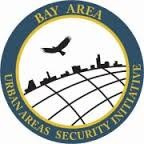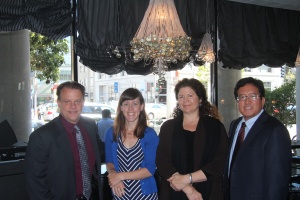In the Bay Area in San Francisco, they have a very interesting model for regional work. Since 2006 12 Bay Area counties and three cities (Oakland, San Francisco and San Jose) have worked together to form the Bay Area UASI (Urban Area Security Initiative). The organisation is funded through FEMA grants in order to provide multi-jurisdictional and multi-agency planning, training and exercising across all of the participating areas and from what I could see they are doing this with a great degree of success. I met with them on my final day in San Francisco.
 One of the programs that they are leading is the integration of emergent volunteers into emergency plans. We have all heard stories of people learning about a large scale disaster and wanting to be able to help and get involved. Many emergency managers can become frustrated with this- not the fact that people want to be able to do their bit, but because untrained and at times unskilled volunteers can create a logistical strain on limited resources- most emergency managers would prefer to deal only with affiliated volunteers, such as Red Cross or Salvation Army volunteers, because they area already trained and are being managed by another organisation.
One of the programs that they are leading is the integration of emergent volunteers into emergency plans. We have all heard stories of people learning about a large scale disaster and wanting to be able to help and get involved. Many emergency managers can become frustrated with this- not the fact that people want to be able to do their bit, but because untrained and at times unskilled volunteers can create a logistical strain on limited resources- most emergency managers would prefer to deal only with affiliated volunteers, such as Red Cross or Salvation Army volunteers, because they area already trained and are being managed by another organisation.Bay Area UASI have taken a different approach. Following the 1989 Loma Prieta earthquake, they were inundated by volunteers from outside the area. The UASI team have been working with Kelle Remmel, an expert in the field of volunteer and donations management to develop the Emergency Volunteer Centre Program. This helps communities in the Bay Area to develop plans to manage spontaneous volunteers during a disaster. At the core of this plan is the Emergency Volunteer Centre- a centralised clearing house which serves as a location where volunteers can be assessed for skills and assigned specific tasks. Kelle has developed an Emergency Volunteer Centre resource kit- a quick start pack, which contains everything needed to set up this kind of centre. This was developed because of the difficulty posed by trying to keep a group of staff or volunteers permanently trained to undertake the task if managing this kind of centre. The pack has been road tested blind with a group of Rotary Club volunteers, and they were able to set up to receive volunteers within 15 minutes of being given the pack.
Kelle is convinced that actually building in spontaneous volunteer into your plans will help increase community resilience. Coordinated volunteer and donations management:
– accelerates faster community recovery
– increases the ability to respond more quickly to vulnerable populations
– enhances economic recovery, because the community don’t have to wait for other organisations to come in and do things for them- they are doing the work themselves
– enables psychological recovery and return to normalcy.
(Remmel, 2013)
Another sector being integrated into planning and response is the Bay Area’s approach to the corporate sector. Public-Private sector integration into emergency operations centres has taken place since 2007 wild fires in San Diego and has continued with other incidents ever since, under the auspices of the California Resiliency Alliance, a non-profit organisation started after Hurricane Katrina. The CRA were concerned about supply chains and the fact that a lot of businesses wanted to be able to help, but did not know who to speak to or how to coordinate their efforts.
The California Resiliency Alliance has a business focus and is unique in connecting the business sector with emergency operations centres. The Bay Area has the second largest concentration of Fortune 500 business, which means that any Bay Area event affecting businesses, is likely to have a global and not just local impact. As a result of a huge amount of networking, relationship building and cross sector events, during the pandemic flu outbreak in 2009, San Francisco Department of Emergency Management was able to host a conference call with over 12,000 local businesses! The key lesson that the CRA has learned is that it is important to build up a network of networks- tap into those relationships that already exist, and also to have formal plans for how the private sector will connect with the emergency management structure.
One of the formal structures for linking business with emergency management is the CalOES BOC (for all you acronym lovers out there, that’s the California Governor’s Office of Emergency Services Business Operations Centre). Their goal is to facilitate economic resiliency through business continuity and recovery, as well as community assistance and donations. Because of this ongoing relationship with the business sector, there is access via 16 businesses partners (huge players like Walmart, Home Depot, UPS etc.) , to a vast pool of resources, including food and water, supplies, transport and banking. Business and the private sector is so ingrained in the response at State level, that the business sector has a conference room on the side of the state emergency operations centre. This is not the only way of doing things though- New Jersey, don’t allow businesses in their EOC, so they have developed a virtual EOC for businesses to be able to feed into emergency response discussions.
The Bay Area UASI and the California Resiliency Alliance have started a smaller project that compliments the state efforts. They will be working with Bay Area companies such as Google, Cisco, Apple and Intel, as well as local chambers of commerce to undertake:
– extensive outreach to engage with local businesses
– the formation of a private sector resiliency advisory committee
– the recruitment and training if business reps for emergency operations centres
– private sector workshops
– the development of a Bay Area Business Operations Centre (BOC) guide and ‘How to start a BOC’ video.
Two great examples of different communities getting involved. So remember – A ‘community’ does not just refer to the residents.
Thanks to Janell Myhre and Craig Dziedzic from the UASI, Kelle Remmel from Remmel Consulting and Peter Ohtaki and Jim Turner from the California Resiliency Alliance, for their time and presentations.


